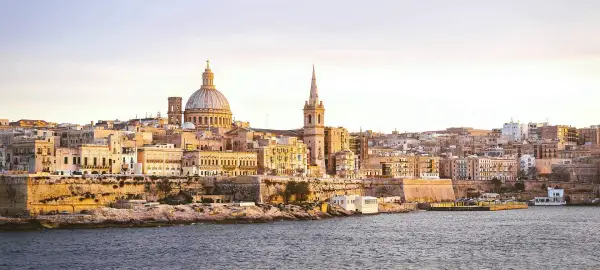- Overview
- Info & Inclusions
- Itinerary
- Map & Hotels
- Photos
- Dates & Prices
- Max Group Size 18
- Guided Valletta harbour cruise
- Pre-historic temples of Hagar Qim and Ggantija, beautiful Gozo
- Colourful fishing village of Marsaxlokk
- Singles friendly (view options for single travellers)
- MealsSavour authentic flavours with included daily breakfasts and dinners at handpicked local restaurants—immersing you in local cuisine without worrying about reservations or budgets.
- Transport & Logistics
Private air-conditioned coaches and included internal ferries and flights—ensuring hassle-free travel so you can focus entirely on the discoveries ahead.
"Adventures Abroad tour leader's management and guest services managed the tour with great skill and dedication. The tour leader was on top of every move and transfer. We have not experienced any issues with logistics and had a great time."
~ JULIA O"The tour leader did an excellent job coordinating some difficult travel logistics, power outage issues and resolving problems and dealing with guests who had unrealistic expectations."
~ CYNTHIA COLLINS - Expert Guidance
Unlock insider secrets at every landmark with your full-time Tour Leader and expert local guides , all gratuities covered—no hidden tipping surprises—so you immerse fully in your destination's stories, worry-free. (Except for the tips to your tour leader at the end of your tour.)
"Amazing tour guide. Our tour guide was very well organized, Her passion, knowledge, and enthusiasm completely transformed the travel experience into something truly unforgettable..."
~ MELANIE LEMAIRE"Highly recommend every trip with Adventures Abroad. It's a well organized and well thought out adventure. The tour leaders are friendly, knowledgeable and experienced professionals. Highly recommend this company."
~ SUSAN WALL - Sightseeing & EntrancesAll entrance fees for sites visited as per the itinerary—no hidden costs—so you can explore ancient ruins and excursions with complete peace of mind.
- AccommodationsUnwind in clean, well-located 3 to 4-star hotels with private en suite facilities—handpicked for comfort and convenience after each day's discoveries—so you can rest easy knowing your stay supports the real adventure, not steals the spotlight.
- Small Group
Discover the world in small groups of up to 18 travellers plus your expert Tour Leader—unlocking spontaneity, off-the-beaten-path adventures, and genuine connections at a relaxed pace, free from crowds.
"Looking Forward to My Next Adventure The best feature of the Adventures tour was the small size that allowed the group to quickly load up, let everyone get acquainted within the first 24 hours, capitalize on unplanned surprises along..."
~ PHILIP BLENSKI"Good value for a great time I have traveled with Adventures Abroad for over 20 years now. Well thought out, interesting itineraries and the other travelers congenial and friendly. The price always seems fair and overall a..."
~ Trusted Customer - Airport Transfers For Land & Air CustomersWe handle hassle-free airport transfers for all our land and air tour customers—plus early arrivals or late departures when you book extra hotel nights directly with us for added peace of mind.
- International airfare to/from the tour.
- Tour Leader gratuities, lunches, drinks, personal items (phone, laundry, etc), international (if applicable), and excursions referenced as 'optional'.
- Airport transfers for Land Only customers.
- Optional trip cancellation insurance.
- Seasonality and Weather:
April/May departures offer Malta's most delightful weather conditions, with warm Mediterranean sunshine balanced by refreshing sea breezes and minimal rainfall—ideal for extensive outdoor sightseeing and photography. This timing precedes peak summer crowds while providing perfect conditions for exploring cliff-top temples, harbour cruises, and walking tours through historic centres.
September/October visits deliver the sweet spot of shoulder season travel, featuring pleasant daytime temperatures and mostly sunny skies with occasional brief showers.
Both seasons showcase Malta's dramatic limestone landscape under optimal lighting conditions, with calm seas perfect for ferry crossings to Gozo and comfortable conditions for the full days of cultural exploration that define this comprehensive island discovery. - Transport and Travel Conditions:
Travel throughout by comfortable, air-conditioned private coach accommodating 24-36 passengers depending on group size. Malta's compact geography ensures manageable driving distances, though the itinerary features full days combining coach travel with extensive walking tours through historic city centres and archaeological sites. Expect frequent walks on cobblestone surfaces, uneven stone pathways, and occasional slopes or stairs typical of European historic districts and cliff-top locations.
This trip is typical of most of our European tours, which are ambitious and involve full days of travel and sightseeing. While we don't have any actual strenuous activity (ie hiking) built into the program, you will do a lot of walking on this trip. These walks will mostly be in the form of walking tours of towns and cities and short walks to dinner. Being Europe, and a hilly/mountainous area, cobbles, uneven surfaces, and slopes/stairs are common. If you are accustomed to typical "bus tours," which rely heavily on vehicular transport for all sightseeing activities, you should be aware that this tour is considerably more active.
Am I suitable for this tour? Please refer to our self-assessment form - Activity Level: 2
These are particularly busy tours that feature a lot of moving around, sometimes by train and short journeys on local transport. Walking tours of towns and cities are leisurely but you should be prepared to be on your feet for several hours. Some of our cultural trips that occur at high altitude and/or require greater independence with baggage handling (at hotels, airports, train stations) also fall into this category.
To learn more about the Activity levels, please visit our tour styles page. - Accommodation:
Well-located, air-conditioned, mid-range hotel well-located for our sightseeing program. Porter service is available (see 'inclusions') though you should be independent with your luggage. Single rooms are limited and likely smaller than twins. - Staff and Support:
Tour Leader throughout, driver (s), local step-on guides in various locales. - Group Size:
Maximum 18 (plus Tour Leader)
- Day 1:Arrival in MaltaWelcome to Malta!
Malta has a greater density of historic sights than any other country. Starting with its unique prehistoric temples, some of the oldest stone buildings in the world, it also has Roman catacombs, medieval towns, and the extraordinary architectural and artistic legacy of the Knights of St John (the Knights of Malta). The British left behind red letter boxes and phone booths, as well as the language, in spite of which Malta (independent since 1964) remains thoroughly Maltese. The country has thankfully shaken off the British culinary legacy and is home to some excellent restaurants specialising in Mediterranean food.
Overnight in Malta.
Included Meal(s): Dinner, if required - Day 2:Valletta: City Tour & Dingli CliffsToday we explore Valletta—Europe's smallest capital at just 1000 by 600 metres—from a vessel showcasing why this location became the Mediterranean's greatest fortress. The city commands two natural harbours whose strategic value shaped 4,000 years of history. Our harbour cruise reveals the defensive genius that saved Christian Europe from Ottoman expansion. In 1565, Jean Parisot de la Valette led 600 Knights of St. John against 40,000 Ottoman invaders in the "Great Siege of Malta." Their miraculous victory prompted Felipe II of Spain to found a new capital worthy of these heroes—Valletta, built on Renaissance military engineering principles.
From Upper Barakka Gardens, we survey Grand Harbour's fortified peninsulas—Senglea and Vittoriosa—their bastions creating interlocking fields of fire that made Ottoman conquest impossible. The Grand Master's Palace, now housing Malta's presidency and parliament, preserves the Knights' aristocratic legacy. Walking through State Apartments where European diplomacy once unfolded, we examine 17th-century Gobelin tapestries depicting scenes from the Americas—reminders that Malta's Knights wielded continental influence. The Palace Armoury houses the world's finest medieval and Renaissance weaponry collection, with thousands of armor suits testifying to the military brotherhood that dominated Mediterranean warfare for three centuries.
"The Malta Experience," screened in the Knights' former hospital, provides us the perfect historical context through a 45-minute audiovisual presentation tracing Malta's story from prehistory to modern independence.
PLEASE NOTE: Malta's Hal Saflieni Hypogeum site and tour is a popular option should you choose to extend your stay outside of our tour. We do not include it in our program as the number of visitors per day is very limited and spaces tend to sell out before many/most of our travellers commit to our tour; as such, promising the visit in our itinerary is problematic. We suggest booking your own visit once our tour is 'guaranteed' to operate.
Overnight on Malta
Included Meal(s): Breakfast and Dinner - Day 3:Valletta & Prehistoric MaltaOur Valetta sightseeing continues to St. John's Co-Cathedral, transforming our understanding of Baroque religious art. Built in the 1570s by Maltese architect Gerolamo Cassar, this masterpiece served as the Knights' spiritual heart. The interior's symphony of gold leaf, marble, and masterful painting demonstrates how military monks expressed devotion through artistic magnificence. Over 300 Knights lie entombed beneath elaborate marble floor slabs, each a decorative masterwork depicting heraldry and achievements. The Cathedral Museum houses Caravaggio's largest painting—"The Beheading of St. John the Baptist"—the only work the master ever signed, created during his turbulent Malta period (1607-1608).
The National Museum of Archaeology introduces Malta's prehistoric temple builders who created the world's oldest freestanding stone structures. These artifacts, dating to the 4th millennium BCE, represent civilizations flourishing 500-1,000 years before Egypt's first pyramids.
At Hagar Qim, spectacularly positioned on cliffs overlooking Fifla islet, we encounter architecture challenging assumptions about prehistoric capabilities. Built between 3600-3200 BCE, these temples demonstrate sophisticated understanding of astronomy and monumental construction. Massive limestone blocks—some weighing over 20 tonnes—were quarried, transported, and positioned using technologies lost to history.
Nearby Mnajdra Temple complex reveals how prehistoric Maltese developed increasingly sophisticated architectural forms. Careful alignment with solstices and equinoxes suggests these weren't merely religious centres but astronomical observatories connecting earthly worship to celestial cycles.
In Marsaxlokk village, brightly painted luzzu boats preserve Mediterranean maritime traditions, their distinctive eye symbols connecting contemporary fishermen to Phoenician customs over 2,500 years old.
Overnight on Malta
Included Meal(s): Breakfast and Dinner - Day 4:Day Trip to GozoThe brief ferry crossing to Gozo transports us to an island that feels like Malta's rural cousin. Gozo maintains a distinct cultural identity and dialect, with landscapes and traditions that modern Malta has largely abandoned. The prehistoric temples of Ggantija rank among humanity's oldest religious monuments, dating back to 3600-3200 BCE. Local folklore attributes their construction to giants, and the megaliths' sheer size is awe-inspiring. Victoria, Gozo's capital, clusters around the fortified citadel of Il-Kastell, which has been continuously fortified for over 4,000 years.
Within the citadel, the Cathedral of the Assumption showcases trompe-l'oeil ceiling paintings that create illusory domes. The Archaeological Museum reveals how successive civilizations adapted the same strategic location to serve their defensive needs. The Folklore Museum provides intimate insights into traditional Gozo life, illustrating how island communities maintained self-sufficiency through ingenious adaptation to limited resources.
At Dwejra, we witness geological forces at their most dramatic. Two enormous limestone caverns collapsed to create today's Inland Sea, a lagoon connected to the Mediterranean through a 100-metre tunnel. Local fishermen guide us through this natural wonder, past the Blue Hole and Fungus Rock, where Knights of St. John once harvested rare medicinal plants. The cynomorium coccineus growing on Fungus Rock was highly valued for its medicinal properties, reminding us how biological diversity creates economic value across cultures. Overnight on Malta.
Overnight on Malta
Included Meal(s): Breakfast and Dinner - Day 5:Mosta, Mdina & RabatThis morning, we visit the Rotunda Church of Mosta, a remarkable architectural achievement that dominates the island's central plateau. Based on Rome's Pantheon, its dome ranks as Europe's third-largest unsupported span. The church's most famous story emerged during World War II, when a German bomb penetrated the dome but failed to explode during evening mass. The unexploded bomb remains displayed as testament to faith surviving warfare's brutal realities.
We then proceed to Mdina, Malta's ancient capital, which preserves the medieval Arab city within massive fortifications. As we walk through the narrow streets, we experience urban planning designed for shade, privacy, and defensive strength. The Cathedral of St. Paul occupies the site where tradition claims the Roman governor Publius welcomed the shipwrecked apostle.
From Mdina's bastions, we take in panoramic views of Malta's landscape, understanding why successive conquerors established strongholds here. Next, we visit the nearby Rabat, where the Domus Romana reveals how wealthy Romans lived beyond official Mdina. The excavated villa's mosaic floors and columned courtyards demonstrate provincial luxury. Finally, we explore the Catacombs of St. Paul and St. Agatha, which preserve early Christian burial practices and feature characteristic agape tables.
Overnight on Malta.
Included Meal(s): Breakfast and Dinner - Day 6:DepartureOur Mediterranean odyssey concludes as we prepare for departure from Malta's international airport.
BON VOYAGE!
Included Meal(s): Breakfast
Countries Visited: Malta
*The red tour trail on the map does not represent the actual travel path.
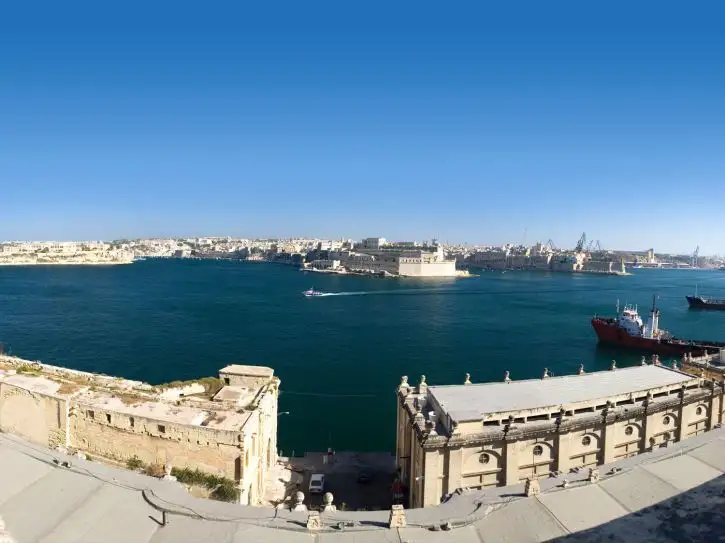

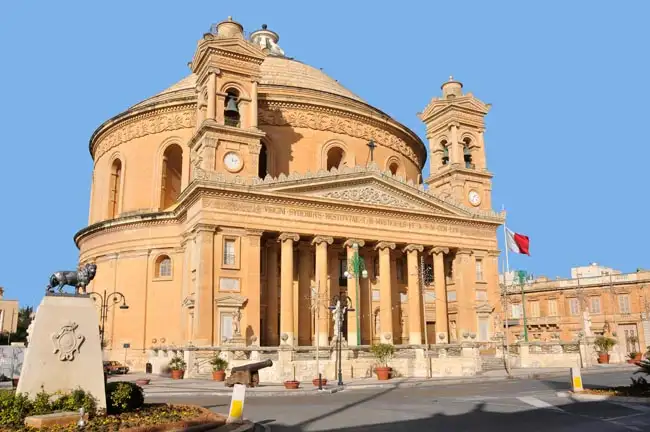

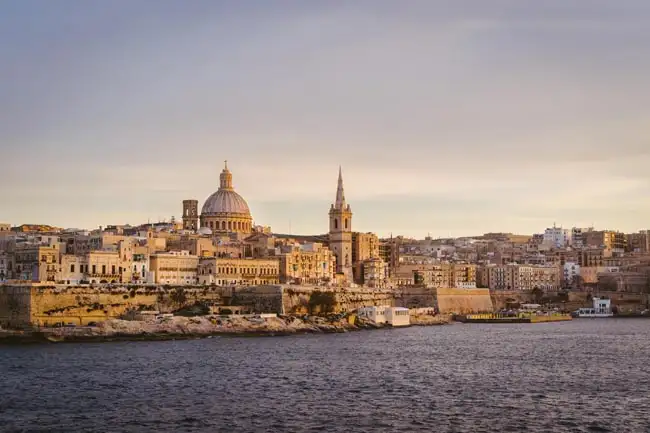
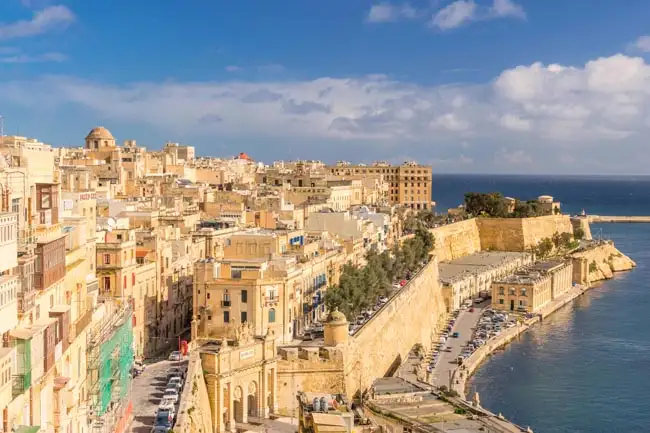
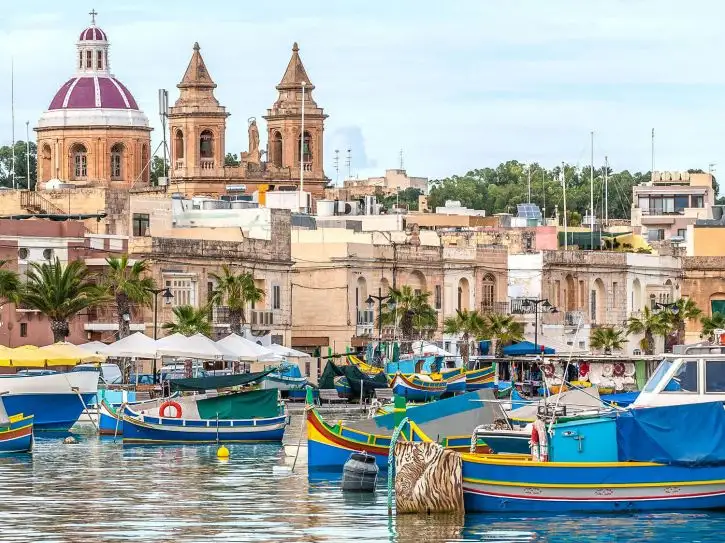
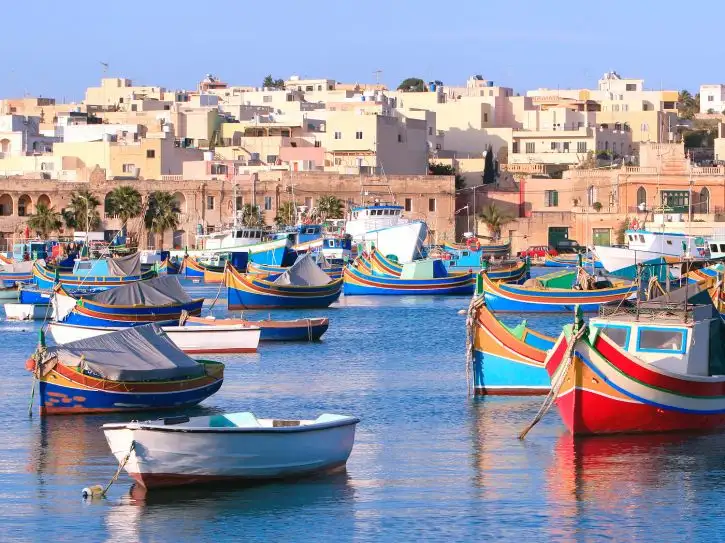

Book This Tour
- Final payment: Due 90 days prior to departure.
- Deposit: A non-refundable $500 CAD Deposit is required at booking.
- Optional Single Supplement: $680 CAD (number of singles limited).
(View options forsingle travellers) - Transfering Tour or Date: Transferring to another tour or tour date is only permissible outside of 120 days prior to departure and is subject to a $100 CAD change fee.
(Read our cancellation policy)
Prices below are per person, twin-sharing costs in Canadian Dollars (CAD). Pricing does not include airfare to/from the tour and any applicable taxes.
Frequently Asked Questions
- What is the maximum number of participants on a trip?Most of our tours carry a maximum of 18 participants; some tours (ie hiking tours) top out at 16. In the event that we do not achieve our minimum complement by our 90-day deadline, we may offer group members the option of paying a "small-group surcharge" as an alternative to cancellation. If all group members agree, we will confirm the trip at existing numbers; this surcharge is refundable in the event that we ultimately achieve our regular minimum. If the small group surcharge is not accepted, we will offer a refund of your deposit or a different trip of your choice.
- Can I extend my tour either at the beginning or end? What about stopovers?Yes, you can extend your tour either at the beginning or the end and we can book accommodation in our tour hotel. Stopovers are often permitted, depending on air routing. Stopovers usually carry a "stopover" fee levied by the airline.
- How do I make a reservation? How and when do I pay?The easiest way to make a reservation is via our website; during office hours, you are also more than welcome to contact us by telephone.
A non-refundable deposit is payable at the time of booking; if a reservation is made within 90 days, full payment is required. Some trips require a larger deposit. If international airline bookings require a non-refundable payment in order to secure space or the lowest available fare, we will require an increase in deposit equal to the cost of the ticket(s).
Early enrolment is always encouraged as group size is limited and some trips require greater preparation time.
Once we have received your deposit, we will confirm your space and send you a confirmation package containing your trip itinerary, any visa/travel permit related documents, invoice, clothing and equipment recommendations, general information on your destination(s), and forms for you to complete, sign and return to us. Your air e-tickets (if applicable), final hotel list, final trip itinerary, and instructions on how to join your tour, will be sent approximately 2-3 weeks prior to departure. - What about cancellations, refunds, and transfers?Please review our cancellation policy page for details.
- I am a single who prefers my own room. What is a single supplement?All of our tours have a single supplement for those who want to be guaranteed their own room at each location.
This supplement is a reflection of the fact that most hotels around the world do not discount the regular twin-share rate for a room by 50% for only one person occupying a room. Most hotels will give a break on the price, but usually in the range of 25-30% of the twin-share rate. This difference, multiplied by each night, amounts to the single supplement.
The conventional amount can also vary from country to country and some destinations are more expensive than others for single occupancy. In order to be "single friendly," the supplements we apply are not a profit centre for us and we do our best to keep them as reasonable as possible.
On most tours we limit the number of singles available, not to be punitive, but rather because many hotels allow for only a limited number of singles; some smaller hotels at remote locations also have a limited number of single rooms available.
Please note that most single rooms around the world are smaller than twin-share rooms and will likely have only one bed. - Do you have a shared accommodation program?Yes! If you are single traveller and are willing to share, we will do our best to pair you with a same-gender roommate. Please note that should we fail to pair you, we will absorb the single supplement fee and you will default to a single room at no extra charge.
